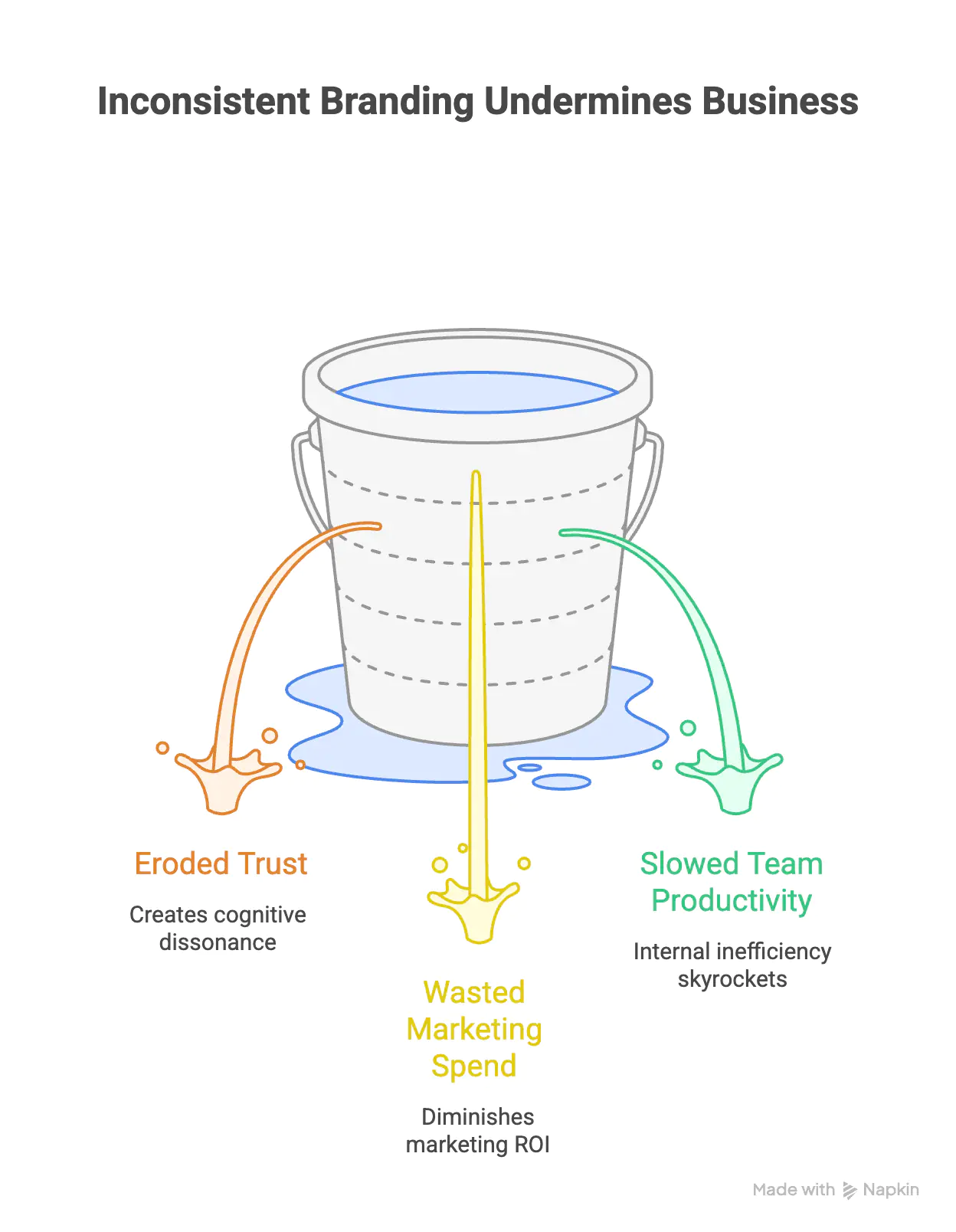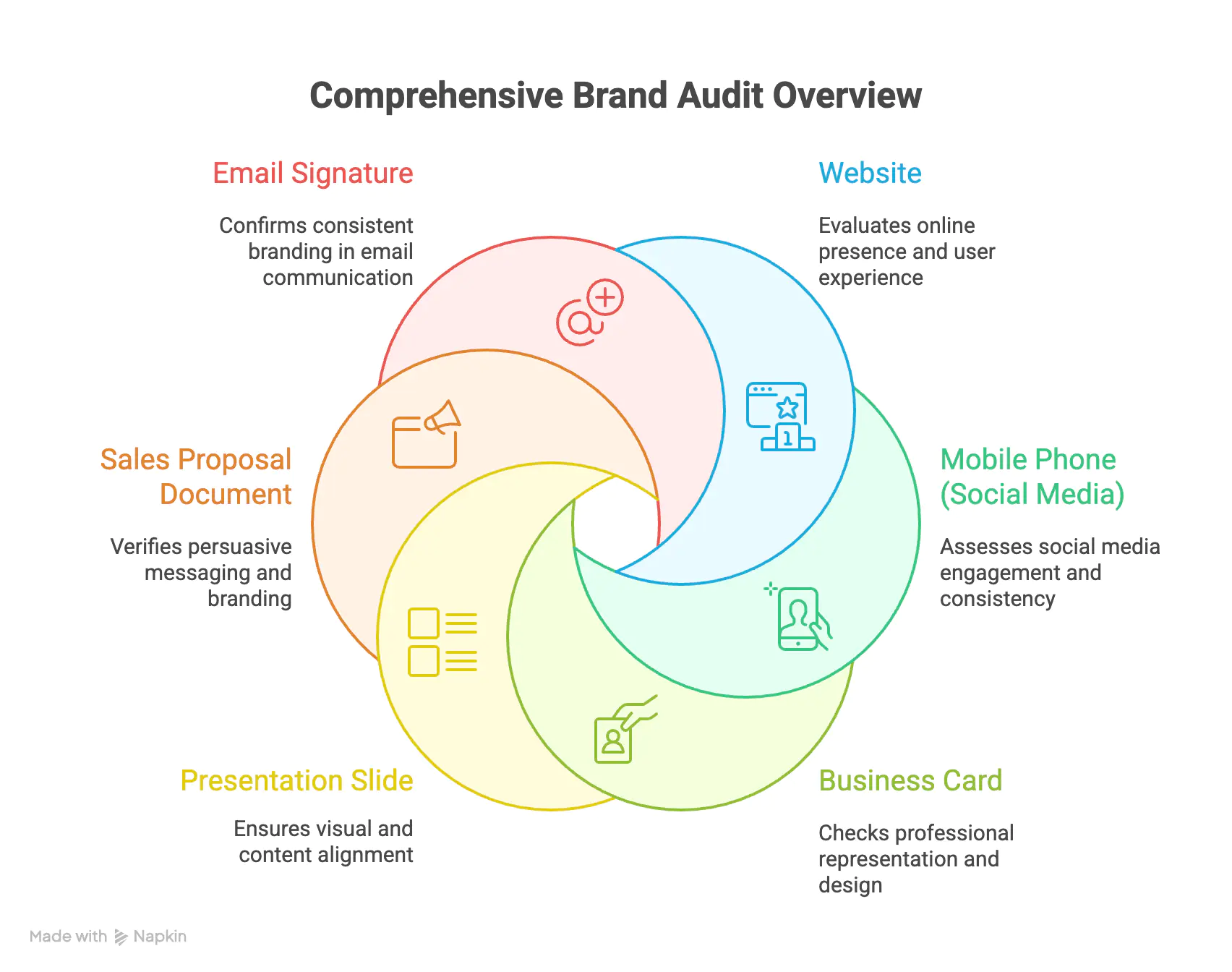Does your sales team describe your company one way, while your marketing materials say something else? Does your logo appear in five different shades of blue across your website, social media, and presentations?
If you're nodding along, you're not alone. Brand inconsistency is one of the most common—and corrosive—problems growing businesses face. It feels messy, unprofessional, and frustrating. But the damage goes far deeper than aesthetics. It's a silent killer of trust and a massive drain on your resources.
The good news? It's fixable. The solution begins with a systematic process of diagnosis: The Brand Audit.
At Studio FLACH, we believe clarity is a strategic advantage. Before you can build a cohesive brand, you must first understand where and why it's breaking down. This guide will walk you through the exact process we use to help our partners turn brand chaos into a powerful, consistent system for growth.
The Hidden Costs of an Inconsistent Brand
Before we dive into the "how," let's be clear about the "why." Brand inconsistency isn't a minor design issue; it's a major business problem with tangible costs.
- It Erodes Trust and Confuses Customers: Trust is built on predictability. When a customer experiences a different visual identity, tone of voice, or message at every touchpoint, it creates cognitive dissonance. They subconsciously wonder, “If they can’t get their own story straight, can I trust them to deliver on their promises?”
- It Wastes Marketing Spend: Imagine spending thousands on a beautifully designed ad campaign that drives traffic to a website that looks and feels completely different. The jarring experience shatters the customer journey, leading to high bounce rates and wasted ad dollars. Every inconsistent asset works against the others, diminishing the ROI of your entire marketing effort.
- It Slows Down Your Team: How much time does your team waste searching for the "right" logo, guessing which font to use, or rewriting marketing copy from scratch for every new presentation? Without a central source of truth, internal inefficiency skyrockles, and team members start creating their own rogue assets, compounding the problem.

"A consistent brand isn't about being boring. It's about being understood. When you are consistently understood, you are consistently trusted."
How to Conduct a Brand Audit: A Step-by-Step Guide
A brand audit is a systematic review of all your brand's touchpoints. Your goal is to gather evidence, identify patterns of inconsistency, and diagnose the root cause.
Step 1: The Gathering Phase – Collect Everything
Your first task is to act like a detective and gather every single piece of material that represents your brand. Don't filter or judge yet; just collect. Create a digital folder and start taking screenshots and saving files.

Key Areas to Audit:
- Digital Presence
Website (all pages), Social Media profiles (LinkedIn, Instagram, etc.), Blog posts, Email newsletters, Email signatures, Digital ads. - Sales & Marketing Materials
Sales decks, Proposals, One-pagers, Case studies, Brochures, Trade show booths. - Internal Communications
Presentation templates, Letterheads, Internal documents, Employee onboarding materials. - Verbal & Written Expression
Website copy, Social media captions, Ad copy, Boilerplate company descriptions, Sales scripts.
Step 2: The Analysis Phase – Identify Inconsistencies
Now, lay out all your collected assets. Group them and start looking for patterns across three key dimensions of your brand.
1. Visual Identity Audit:
- Logo: Is the same logo used everywhere? Are there old versions floating around? Is it being stretched, recolored, or placed on busy backgrounds?
- Colors: Do you have a consistent primary and secondary color palette? Or are there 10 different shades of "your" blue in use?
- Typography: Are the same fonts used for headlines and body text across all materials? Is spacing and hierarchy consistent?
- Imagery: Do your photos and graphics have a consistent style, tone, and quality?
2. Verbal Identity Audit (Messaging & Tone):
- Tagline/Value Proposition: Is your core message the same on your homepage, your LinkedIn profile, and your sales deck?
- Tone of Voice: Does your brand sound professional and authoritative in one place but casual and jokey in another? Read copy from different assets aloud. Does it sound like it's coming from the same "person"?
- Key Terminology: How do you describe your services, your process, or your company's mission? Is that language consistent?
3. Experiential Audit (User Journey):
- Map the journey a customer takes from seeing a social media ad to landing on your website and filling out a contact form. Is the experience seamless, or is it disjointed?
- Review your sales process. Does the experience of talking to a salesperson align with the promise made on your website?
Step 3: The Synthesis Phase – Create an Action Plan
With your analysis complete, you'll likely have a mountain of evidence. The final step is to synthesize it into a clear, actionable plan.
- Create a Simple Report: Document your findings. A simple presentation with "Good" (consistent) and "Bad" (inconsistent) examples for each category works wonders. This visual evidence is crucial for getting team buy-in.
- Identify Key Themes: What are the 3-5 biggest recurring problems? (e.g., "Our logo is used incorrectly in 80% of sales decks," or "Our core value proposition is described in four different ways.").
- Prioritize and Assign: Decide which issues are most critical to fix first. Usually, core digital assets like the website homepage and social profiles are top priority.
The Ultimate Solution: A Centralized Brand Guideline System
A brand audit is the diagnosis. Brand guidelines are the cure.
The root cause of inconsistency is almost always the lack of a single source of truth. A brand guideline document (or a more robust digital brand system) is the rulebook for your brand. It defines exactly how your brand should look, sound, and act. It’s the tool that empowers your team to create materials that are consistently and correctly on-brand, every single time.
A comprehensive guideline should include:
- Logo usage rules (do's and don'ts)
- Official color palettes (with HEX, RGB, and CMYK codes)
- Typography hierarchy (fonts, sizes, weights)
- Voice and tone principles
- Imagery style guidance
- Core messaging and boilerplate copy
From Chaos to Cohesion

Fixing a broken brand experience is one of the highest-leverage activities a business can undertake. It rebuilds trust, increases marketing effectiveness, and empowers your team. The process starts with the honest, methodical work of the brand audit. It gives you the clarity you need to stop patching holes and start building a truly cohesive brand system.
Feeling overwhelmed by your brand's inconsistency? A brand audit is the first step in our partnership process.
Book a complimentary assessment call, and let's bring clarity to your brand together.

